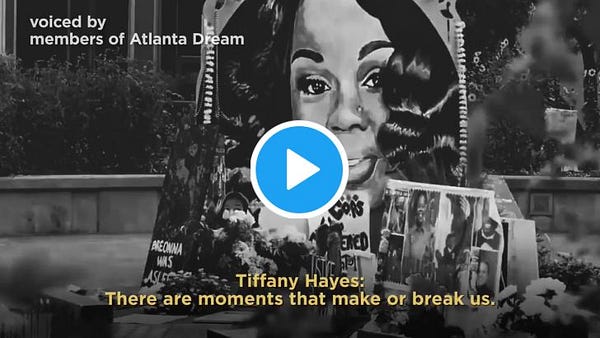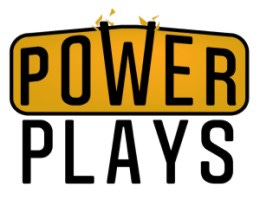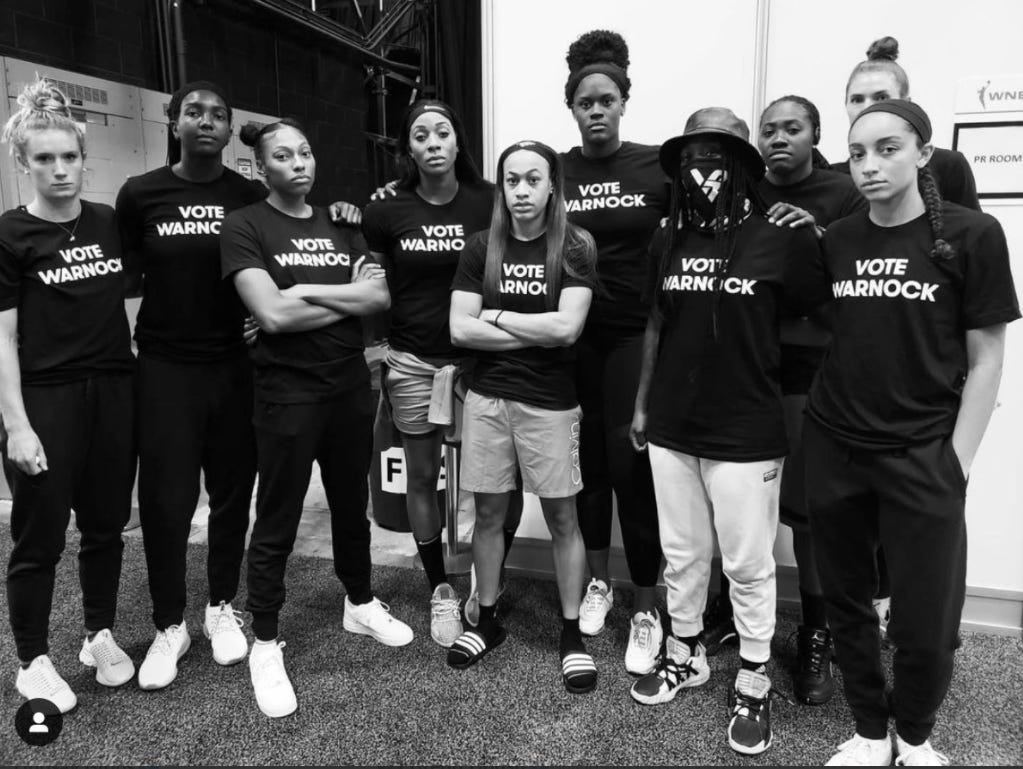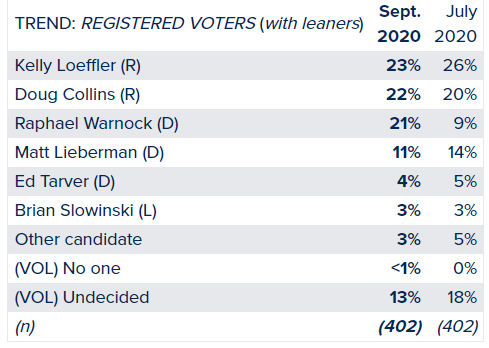Thanks to WNBA players, American democracy has a fighting chance
Plus, a look back to the founding of the Atlanta Dream.
Hi friends. Welcome back to Power Plays, a no-bullshit newsletter about sexism in sports.
Happy 2021! I hope that the calendar change has, at the very least, allowed you a chance to take a breath and mentally reset, even if only momentarily. It certainly has for me.
However, to quote Madame Vice President-Elect Kamala Harris, “2020 ain’t over until January 5th.” That’s today. It’s runoff election day in Georgia. Control of the United States Senate quite literally hangs in the balance. Both Democratic candidates — Rev. Raphael Warnock and Jon Ossoff — need to defeat their Republican opponents, Sen. Kelly Loeffler and Sen. David Perdue, respectively — in order for the the gavel to be pried from Mitch McConnell’s cold, purple hands. Considering we’re in the middle of a deadly pandemic and President Trump is attempting a coup, the stakes are pretty high!
What does any of this have to do with women’s sports, you might be asking? Well, honestly I’d still be writing this intro even if there wasn’t a Power Plays tie-in, because it’s just that important. However, in today’s newsletter, we’re examining how WNBA players are responsible for making this entire scenario possible in the first place.
There’s also an archival treat that revisits the founding of the Atlanta Dream, featuring a wonderful guest star.
BUT FIRST, it’s easy for those of us outside of Georgia to feel helpless right now, especially considering pandemic restrictions, but thanks to my wonderful Twitter followers, I’ve got a list of a few ways you can pitch in to help Ossoff and Warnock in the FINAL COUPLE OF HOURS.
The Working Families Party and Black Lives Matter are hosting phone banking today.
Resistance Labs is another wonderful group to text and phone bank with. I love their trainings.
You can still donate to the campaigns of Jon Ossoff and Rev. Raphael Warnock via ActBlue.
Also, ProGeorgia’s website has a list of a lot of great organizations in Georgia that you can help support.
If you need motivation to act, let me present you with:
Okay, friends. Let’s do this.
WNBA players (hopefully) save America
When Atlanta was awarded a WNBA team in 2007, it took a while to settle on a name for the franchise. But fan voting and executive decision-making eventually dubbed the team the Atlanta Dream, a reference to Atlanta native Dr. Martin Luther King Jr.’s famous, “I Have A Dream” speech, a passionate plea for the nation to dismantle systemic racism and “make real the promises of democracy” delivered in front of the Lincoln Memorial at the March on Washington for Jobs and Freedom in 1963.
Since 2010, the Dream have been co-owned by Sen. Kelly Loeffler (R-GA), who publicly transformed from a fairly anonymous billionaire businesswoman into a Q-Anon courting, pandemic-profiting, partisan political fiend in late 2019, when Gov. Brian Kemp (R-GA) appointed her to Georgia’s open Senate seat.
Here are just two example of what has happened since: In July, one day after WNBA players arrived at the IMG Academy in Bradenton, Florida, to begin their 2020 season in an isolated, (hopefully) covid-proof bubble, Loeffler wrote an open letter to WNBA commissioner Cathy Engelbert publicly attacking the league’s racial justice initiatives, saying, among other things, “I adamantly oppose the Black Lives Matter political movement.” Then, yesterday, Monday night, on the eve of the Georgia Senate runoffs, Loeffler proudly stated that she would undermine democracy and object to the Electoral College vote in the Senate on January 6, joining a last-ditch and futile attempt at a coup to overturn President-Elect Joe Biden’s victory in November.
Today could be the last day of Loeffler’s political reign; in Georgia’s special election, voters will decide between her and Democratic candidate Rev. Raphael Warnock, the senior pastor at Atlanta’s Ebenezer Baptist Church, which is considered King’s spiritual home; his father, Rev. Martin Luther King Sr. was a long-time senior pastor at the church, and King joined him as co-pastor in 1960, eight years before he was assassinated.
It’s poignant, in the most gut-wrenching way, that if Warnock does defeat Loeffler today, it will be largely due to the endorsement of Dream players and their WNBA counterparts.
That’s a bold statement, I know. And it is not one I make lightly, nor is it meant to dismiss the work of the real heroes, the activists and organizers on the ground in Georgia. But I’m not alone in this assessment, and data backs it up — the Washington Post, USA Today, BuzzFeed, and even Warnock himself have all stated that the WNBA’s endorsement of Warnock played a pivotal role in his campaign.
A Monmouth University Poll released at the end of July had Warnock polling at just 9% in the Senate race, behind Democrat Matt Lieberman (14%), Republican Doug Collins (20%), and Loeffler (26%).
But on August 4, players from the Atlanta Dream and their opponents, the Phoenix Mercury, departed their busses in Bradenton wearing black t-shirts with bold white letters saying, “VOTE WARNOCK.” That game was aired on ESPN, so the move got national attention. Players from other teams, such as the Chicago Sky, Connecticut Sun, Las Vegas Aces, and Seattle Storm, wore the shirts pre-game that week, too.
In the 72 hours after the endorsement, Warnock’s campaign received nearly $240,000 in donations and 4,000 new donors. Over the next few weeks, Warnock’s campaign went from an afterthought to a juggernaut.
On August 5, the Warnock campaign began selling the “Vote Warnock” t-shirts worn by the WNBA players. On August 13, Warnock held his very first state-wide (virtual) town hall. On August 19, the Warnock campaign launched its full merch store, and , most importantly, launched his very first television ad.
The next Monmouth University Poll on the race, taken in September, showed that Warnock’s support had skyrocketed from 9% to 21%, almost even with Loeffler and Collins, and 10 points ahead of Lieberman.
On September 29, a Quinnipiac poll showed Warnock ahead in the race, polling at 31%, compared to Loeffler’s 23% and Collins’ 22%. There was no looking back.
What went into the decision to endorse Warnock
Many of you know this story, which has been covered extensively here at Power Plays and in many other outlets. But I think on such an important day, it’s crucial to revisit what went into the decision for the WNBA players to endorse Warnock.
On July 10, just a few days after Loeffler’s inflammatory open letter that disparaged the WNBA’s #BlackLivesMatter and #SayHerName initiatives, the players of the Atlanta Dream released a joint statement, which read in part, “Our team is united in the Movement for Black Lives. It is not extreme to demand change after centuries of inequality. This is not a political statement. This is a statement of humanity.”
The note didn’t mention Loeffler by name — in fact, WNBA players purposefully did not include Loeffler’s name in any of their statements, an attempt to not give her any more attention. But behind the scenes, Dream players and leaders on the WNBA Players Association were working on other ways to use their platform to elevate their message. They didn’t want to be reactionary and resentful; they wanted to be purposeful and productive.
“We wanted to be bigger, more impactful,” Dream center Elizabeth Williams, who is also the secretary of the WNBPA, told Power Plays last summer. “We obviously wanted to say something, but we wanted an action behind it.”
Over at ESPN, Katie Barnes and Ramona Shelbourne had a detailed report last summer about what was going on at IMG in the weeks leading up to the Warnock endorsement:
Williams wanted the Dream to wear something to promote social justice to their opening game on July 26. Then on Aug. 4, in a nationally televised game in prime time, she wanted them to wear something directed at Loeffler that would land with the same force her letter had landed with them.
The executive committee's group text chain started humming with ideas. Finally, Bird came up with the idea of endorsing Warnock, one of Loeffler's Democratic challengers.
"We were having internal conversations about how to keep approaching the Kelly Loeffler stuff," Clarendon says. "And [union president] Nneka [Ogwumike] and I both were like, 'Sue, as a white ally, you have to take this on. We can't muster any more of this. It's too hurtful.'
"The weight of experiencing this as a Black player is different than Sue experiencing it as a white player. The stuff [Loeffler] said is just ridiculously hurtful, even if you haven't played on her team, just calling people 'mob rule' and all that."
Bird understood. She set up Zoom calls with Warnock to vet the candidate the 144 women in the WNBA were about to throw their support behind. She set up Zoom calls with each team so players understood why they were escalating this fight.
She ordered T-shirts for players on all 12 teams to wear to their games on Aug. 4 and 5.
One by one, players from Dream rookie Chennedy Carter to Mercury veteran Diana Taurasi filed into the IMG Academy in Bradenton, Florida, wearing the black T-shirts with "Vote Warnock" in bold white lettering.
"I'm not some political strategist," Bird says. "But what I do know is that voting is important. And I think our league has always encouraged people to use their voices and to get out and vote.”
It’s important to stress a couple of things. First of all, as we previously mentioned, Warnock was not the highest-polling Democrat in the race at the time, so it was not a foregone conclusion that the WNBA players would support him. But they happened to have connections with Warnock thanks to former WNBA president Lisa Borders and Stacey Abrams, the leading force behind the push to turn Georgia “blue” and a member of the WNBPA’s Board of Advocates. Still, even though they knew that Warnock had Abrams’ endorsement, the players all did their homework. This was not just about one-upping Loeffler; this was about searching for a candidate that truly believed in the things they believed in, that could be a true force of good for the country.
Warnock, meanwhile, had no clue what was coming when he was invite to the Zoom call with the WNBA players. He told Nancy Armour at USA Today that he thought the conversation was just going to be a “pep talk,” simply a chance for him to express his pride and support.
“I was surprised that their co-owner, Kelly Loeffler, would use them in such a cheap and obvious way, as a political foil, for her own political purposes,” Warnock said. “I was happy that I was able to talk to them, to encourage them to continue to stand up.”
But soon, the players started to grill him about his positions and policies and history of activism. They liked what they heard.
“He explained all the work that he had done, his role as an activist, his support for women’s rights, reproductive health, universal health care – all of these issues that are important to our social justice movement,” Williams said in an essay on NBC’s On Her Turf.
It was clear to all that Warnock — who proudly calls himself a “pro-choice preacher” — was a candidate they could get behind.


The endorsement was part of a movement, not a one-off moment
As I’ve been maniacally consuming all news about Georgia politics over the past few months, it’s become clear that this shift away from being a gimme state for Republicans didn’t come overnight. Abrams first devised a plan to elect Democrats in Georgia over a decade ago, and the groundwork she laid really started to catch fire after 2016, when the state — and progressives across the country — got the worst wakeup call of all time, in the form of Trump’s election.
The first big sign of the shift came in early 2017, when Jon Ossoff nearly upset Karen Handel (R-GA) in a special election for Georgia’s 6th congressional district, which had been a longtime Republican stronghold. In 2018, Lucy McBath (D-GA) finished the job and actually did oust Handel, defeating her by one point. (McBath defeated Handel again in 2020, this time by 10 points.) That same year, Abrams nearly won the governorship in Georgia in a race that was plagued by voter suppression. Abrams spent the last two years solely focused on registering and mobilizing voters in Georgia, which clearly paid off in 2020, when Georgia voted for Joe Biden. Now, if Ossoff and Warnock both win their special elections today, Georgia will flip the Senate.
Similarly, WNBA players didn’t just discover activism last summer.
(Of course, given the WNBA is a women’s sports league made up predominantly of Black women and many openly queer players, the league itself is inherently political. But I want to stress that this article is not about the WNBA as an institution — in fact, the WNBA has been incredibly silent about everything Loeffler-related and there is no open movement to force her to sell the team. Rather, we’re talking specifically about the players.)
In 2016, weeks before Colin Kaepernick first took a knee, the WNBA players wore Black Lives Matter t-shirts and spoke out against police murdering Black people. When the WNBA fined the players for violating pre-game uniform rules, the players banded together and held media blackouts, where they only discussed police brutality and systemic racism. The league ultimately rescinded the fines. Since then, players across the league have advocated for abortion rights, denounced the Muslim ban, fought for trans rights, and persistently plead for racial justice, among other things.
All the while, they secured the biggest collective bargaining agreement in the history of pro women’s sports.
These players rose to the moment last summer with their Warnock endorsement because they’d already been climbing the ladder together for years. And they haven’t stopped stepping up.
Since the 2020 WNBA season ended and the players departed the Wubble, many have continued to use their voices and platforms to support Warnock’s campaign.
He joined many WNBA stars on December 1 for a panel about athlete activism, a few Dream players led their voices to a PSA for “More Than A Vote” released this week, and reigning WNBA Finals MVP Breanna Stewart recently hosted Warnock on her podcast, “Stewie’s World.”
In that conversation, Warnock praised WNBA players for their work last summer.
“You made it clear that just because somebody owns the team, it doesn’t mean they own you or your voices,” he said.
It’s hard to wrap any of this up in a succinct and impactful way, especially because we won’t know the results of the election until tonight. (Well, hopefully we’ll know tonight. It’s still super close to 2020, so who knows.) But I wanted to publish this piece today, because what the WNBA players did last summer truly raised the bar for athlete activism — a bar that they set themselves.
No matter what happens on Tuesday in Georgia, we must remember that the actions of WNBA players weren’t merely a footnote during this period of political history; they were a driving force.


From the archives: The founding of the Dream
Okay, so, by now you understand how important the Dream have been to this election. Well, to tie EVERYTHING UP IN A BOW, here’s an article on former WNBA president Lisa Borders’ role in bringing the Dream to Atlanta. I literally squealed when I saw who was quoted on the front page.
This is from The Atlanta Constitution on July 31, 2008:
(These are two separate pages, read the first screenshot in its entirety before moving to the screenshot below.)
Of course, this is Power Plays, so I couldn’t let you all go without providing you with a dose of RAGE and STUPIDITY.
You know how I mentioned up top that it took a while to decide on “Dream” as the name for Atlanta’s WNBA team? Well, on October 17, 2007, the Atlanta Constitution solicited reader suggestions for names, and it went just about as well as you’d think!!!
Thanks for reading Power Plays, friends. Remember to subscribe and share if you have a second. Paid subscriptions make this work possible. Big things to come.











